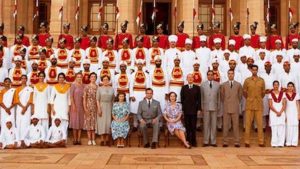Dinner with the Mountbattens in Gurinder Chadha’s VICEROY’S HOUSE
(Gerry Furth-Sides) Gurinder Chadha’s VICEROY’S HOUSE film is as transplendent as the palatial New Delhi home of the same name in 1947 when India was indeed the “Jewel in the Crown” of the British Empire.
The current release of VICEROY’S HOUSE commemorates the 70-year anniversary of the partition of British India into Muslim-majority Pakistan and Hindu and Sikh-majority India. Chadha (Bend It Like Beckham) brings in the perspectives of both the privileged British along with those of the Indians who worked in and resided near “the” house. It is also a glimpse into the cuisine and culture of the British in India at the sunset of their stay. For film details and trailer, please see: “Viceroy’s House”.

Photos of the original and the film version (above) Viceroy’s House residents and staff are nearly identical.
The film begins with it newly occupied by the recently dispatched Lord Mountbatten and family to oversee India’s complicated move to Independence. Mountbatten (Hugh Bonneville), has shared arrivals at former posts with fashionable, playgirl wife, Edwina (Gillian Anderson), and daughter Pamela (Lily Travers), but never on this scale. The Mountbattens presided over 500 Hindu, Muslim and Sikh servants for the needed for the 340-room HOUSE.
Mountbatten held the post for only six months in 1947 during which he and his wife Edwina were renowned for their lavish parties. The parties extended to the outdoor landscaped gardens, where the Mountbattens took leisurely tea with the statesmen of the day with the likes of Mahatma Gandhi, Jawaharlal Nehru, and Muhammad Ali Jinnah.
“Big-bellied copper pots to prepare pints of steaming turtle consomme. Metal cutlet bats to tenderize beef into butter-soft filet mignons. Gleaming silver salvers to carry in main courses like quail stuffed with grapes for banquets at ‘Viceroy’s House’, as Rashtrapati Bhavan was known before Independence. These were the ‘imperial measures’ used in the kitchens and dining rooms of the Crown and all her colonies.”
For a marvelous detailed look at the restored restaurant version, please see: //www.outlookindia.com/magazine/story/dinner-with-edwina/231823
At 200,000 sq ft, it was one of the largest seats of government in the world and has been described as “the last great palace ever built” (Chadha was able to shoot the exterior scenes at the original Viceroy’s House in New Delhi, now the Indian president’s residence).
Chadra talked with Lord Mountbatten’s aide-de-camp and author Maharajah, Narendra Singh Sarila extensively. Sarila revealed how Indian luxury at the time contrasted with England still suffering from war-rationing. When servants brought in a gleaming silver tray of beef for the Mountbatten’s pet dog their first day, they were tempted to eat it themselves!
The socialite world of the Mountbattens turned inside out in India, brought out an altruistic side of Edwina, who traveled into the city often, instructing her staff to include Indian dishes for every banquet.
Gurinder, who is known to be a feminist, said that custom of Indian women cooking and men eating separately was “terribly sexist. ” She added, “When I was a teenager I remember rebelling against cooking time-consuming dishes, particularly the roti. You had to put the dough on the hot griddle and it had to be done just so. ‘What will your mother in law say when you get married if I don’t teach you how to do it properly?’, my mother would beseech me, and then my name will be pulled through the mud!’
“However,” she laughed, “10-year-old son loves to make roti. He loves just getting right in there and does it all the time.
Does food bridge a gap between cultures? “Absolutely.” Chadha reminds us, “What’s cooking?” is the most popular, friendly phrase in the world.



 Gerry Furth-Sides
Gerry Furth-Sides  Barbara Hansen
Barbara Hansen  Chef-owner Alain Cohen
Chef-owner Alain Cohen  Roberta Deen
Roberta Deen  Jose Martinez
Jose Martinez  Nivedita Basu
Nivedita Basu